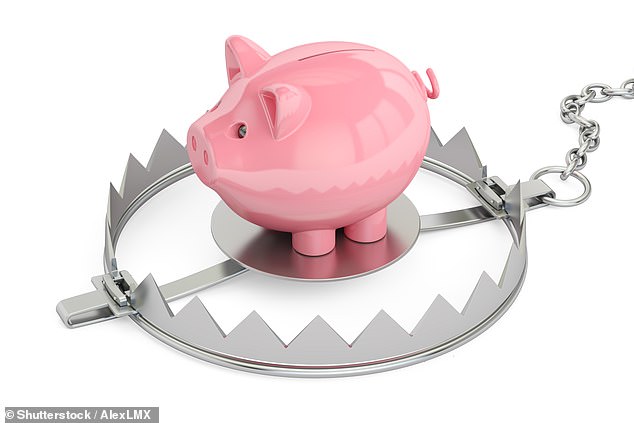Table of Contents
When looking for a new savings account, it can be tempting to choose the one at the top of most best buys charts.
But banks and building societies use all sorts of tricks to get to the top of these tables.
That means those who do are not necessarily the ones who will be the best choice for you.
Behind the shiny facade of higher rates may be a number of restrictive terms and conditions.
Every week I put together my Star Buys table and to make the cut, savings providers need to do a lot more than just offer great rates.
Hidden fees: Banks and building societies use all sorts of tricks to get to the top of the best buy tables, so those that do this won’t necessarily be the best option for you.
But other lists of top savings rates can have more simplistic methodologies and often simply list the accounts with the best rates.
So if you use them, be sure to follow my checklist to ensure you get a great, well-rounded account that won’t prove restrictive later on.
And remember, if you opt for an easy-access account, the rates are variable so the provider can modify them at any time and will not always notify you.
Check rates regularly, at least once a month, to ensure you’re still getting a competitive deal.
Beware of Huge Minimum Balances
The highest paying accounts usually have a huge minimum balance. For example, you need at least £10,000 to get the top rate of 5.1 per cent from Close Brothers Savings.
Ask yourself: If you have that much money to put in a savings account, do you really want to keep it in an easy-to-access account or could you keep it locked away longer or even invest it?
If you think you’ll need to withdraw money for an emergency, your rate could plummet, down to a dismal 1 percent in the case of the Close Brothers Savings Account.
Your £10,000 will get you £510 a year, around £42 a month. But £9,999 in the account for a month equates to just over £8 rather than the full £42 – a costly mistake.
Monument Bank at 5.08 per cent asks for an even higher minimum of £25,000 deposited with the bank across all its savings accounts.
On the other hand, Family Building Society Online Saver, at 5.04 per cent, pays you a little less, but you can open it with just £100.
See when and how much you can withdraw
Some accounts that claim to be easy access have minimum withdrawals, such as Shawbrook Bank’s 5 per cent on £1,000 or more, but withdrawals must be at least £500.
Check how long it takes to get cash
Some providers pay withdrawals into your checking account instantly. With others you have to wait a day, or even two.
Beware of the ‘bonus’ that disappears
Some providers pay a ‘bonus’ rate for the first 12 months, but make sure the bonus goes away or you could end up with a much lower rate.
Post Office Online Saver pays 4.7 per cent for the first year, after which it drops to 1.55 per cent.
Others pay a much smaller bonus, so you don’t lose much when it disappears.
Be careful with the withdrawal limit
Some accounts limit the number of times you can withdraw money each year; in some cases, only two.
Providers like to offer these accounts because they cost less to administer.
Deposit the base rate with this peculiar account

Skipton Building Society’s Base Rate Tracker voucher guarantees that the rate you get will match the Bank of England base rate.
Skipton Building Society has launched a new account, with a twist.
It’s worth a look if you think interest rates won’t fall much in the near future.
The Base Rate Tracker bonus locks in your money for up to two years and guarantees that the rate you get will match the Bank of England’s base rate, currently 5.25 per cent.
It’s riskier than a fixed-rate bond where you know exactly how much interest you’ll earn, but it could be a better deal.
It pays a better rate than the best two-year fixed rate bond currently offered between 4.91 and 4.96 per cent at internet-based banks such as DF Capital, Close Brothers and SmartSave.
Among the high street banks, the best two-year rate is Furness’s 4.75 per cent, although most pay between 4 and 4.4 per cent.
If the base rate goes up or down, so will the rate you earn on the Skipton bonus. But the problem is that you can’t withdraw your money if rates fall.
As no one can be sure what the Bank of England will do next, I would use as much of the £20,000 tax-free cash Isa allowance as possible before considering any other bonuses.
sy.morris@dailymail.co.uk
Some links in this article may be affiliate links. If you click on them, we may earn a small commission. That helps us fund This Is Money and keep it free to use. We do not write articles to promote products. We do not allow any commercial relationship to affect our editorial independence.


